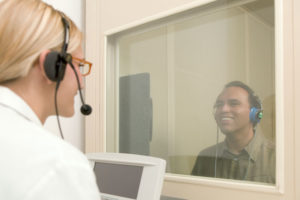
Audiology evaluations consist of a series of tests used to determine whether a hearing loss exists and, if so, measure its type, degree and configuration. An audiologist will assess the results of each individual test in order to develop a treatment plan geared toward your unique hearing loss.
Who Should Be Given an Audiology Evaluation?
An audiology (or hearing) evaluation can benefit patients of all ages, even those who do not exhibit signs of hearing loss.
Hearing loss is a progressive condition that often develops slowly. Many people are not aware of a change in their hearing because they gradually adapt to the subtle changes in their hearing ability over time. Studies indicate that it takes seven years, on average, for a hearing impaired individual to seek treatment.
An audiology evaluation should be the first course of action for anybody who even suspects a hearing loss. The sooner a diagnosis of hearing loss is made, the more successful treatment will be. Early detection means more options for the patient.
Many physicians urge making audiology evaluations a routine part of your overall health care, much like regular vision exams and dental checkups. They are quick, painless and provide immediate results.
What Does Diagnostic Testing Entail?
A comprehensive audiology evaluation consists of a series of individual diagnostic tests that measure different aspects of your hearing. Following a physical examination and a review of your medical history, you will be given any or all of the following tests:
Pure Tone Testing
Pure-tone testing (also known as pure tone audiometry) uses air conduction to measure your ability to hear sounds of various pitches and volumes. Wearing headphones, you will be asked to identify a series of tones by raising a hand, pressing a button, or responding verbally.
The results are charted on an audiogram, a graph that shows the type, degree and configuration of your hearing loss by comparing pitch (frequency) with loudness (intensity). The pattern recorded will help your audiologist determine your hearing threshold.
Bone Conduction Testing
Bone conduction testing is another type of pure-tone test that measures the inner ear’s response to sound. If there is damage or a blockage in the outer or middle ear, bone conduction audiometry testing may be used.
Instead of sending the tones through the ear, this type of testing is able to bypass the outer and middle ear and send the tone directly to the inner ear. A small vibrator is placed behind the ear. The device sends out a vibration that passes through the skull bone to reach the inner ear.
If the results of this test are different than the air conduction test, your audiologist can use this information to determine whether you have a conductive or sensorineural hearing loss.
Bone conduction testing is often used in place of air conduction testing when an obstruction in the outer or middle ears is present.
Speech Testing
Speech testing is used to measure your speech reception threshold (SRT), or the faintest speech you can understand 50 percent of the time. This is compared with your pure-tone test results to confirm the diagnosis. In addition, your ability to separate speech from background noise will be recorded.
Speech testing may be administered in either a quiet or noisy environment; results are recorded on the audiogram for easy visual reference.
Tympanometry
Tympanometry is a test of the middle ear used to detect wax buildup, fluid, eardrum perforations, diseases involving calcification of the ear and tumors. It measures movement of the eardrum in response to air pressure; the results are recorded on a chart called a tympanogram.
Acoustic Reflex Testing
Muscle contraction in the ear is nature’s way of protecting you from loud sounds, the acoustic reflex test measures these involuntary muscle contractions of the middle ear, and is used to determine the location of your hearing problem (the ossicles, cochlea, auditory nerve, etc.) as well as the type of hearing loss.
Auditory Brainstem Response (ABR)
Auditory brainstem response testing is used to determine if there is neural involvement in the loss or if the hearing loss extends beyond the ear to the auditory pathways in the brain.
In an ABR test, electrodes are attached to your head, scalp or earlobes, and you are given earphones to wear. Your brainwave activity is measured in response to sounds of varying intensities.
Otoacoustic Emissions (OAEs)
Otoacoustic emissions (OAEs) are sounds generated by vibrations of the hair cells in the cochlea of the inner ear. OAE testing utilizes a tiny probe fitted with a microphone and speaker that is used to stimulate the cochlea and measure its response. Abnormal responses confirm the hearing loss is coming from the inner ear.
OAE testing is often included in newborn hearing screening programs.
